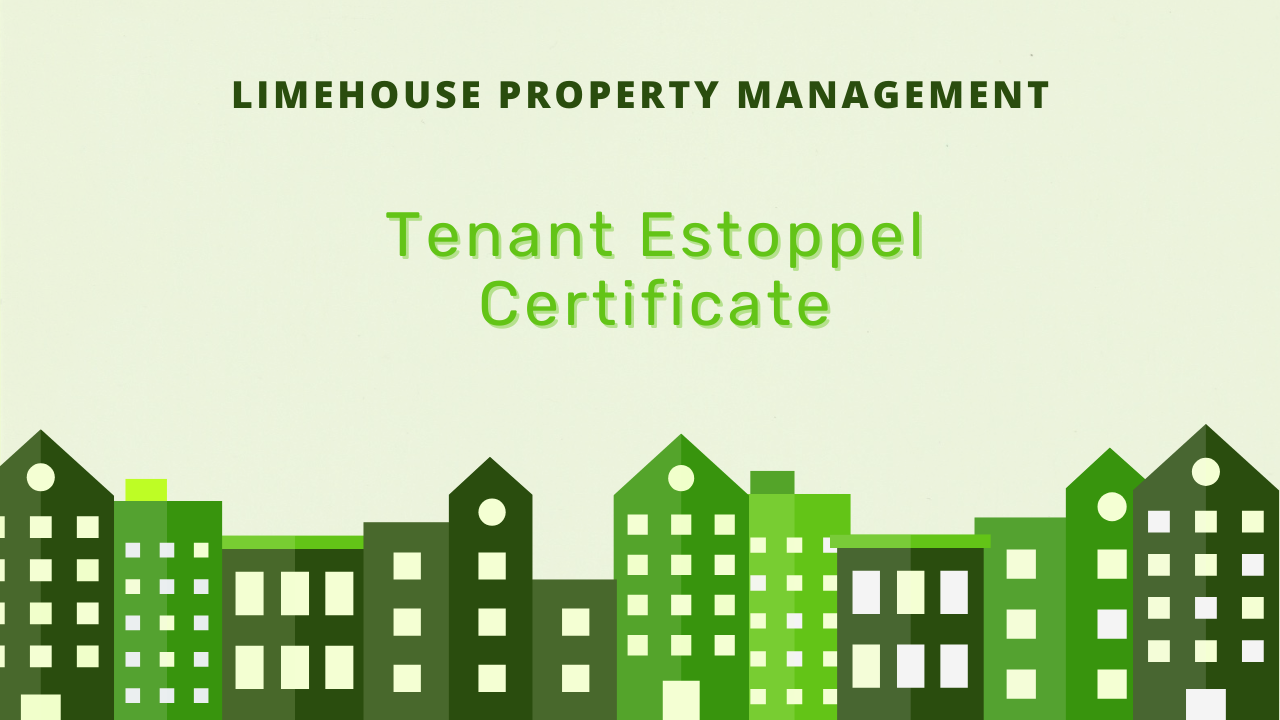Tenant Estoppel Certificate

Have you ever found yourself tangled in the fine details of tenant agreements during a property sale or refinancing process? If so, you’re not alone. Many landlords face this challenge, but understanding Tenant Estoppel Certificates can make a big difference.
A Tenant Estoppel Certificate confirms the key details of a tenant’s lease, such as rent amount, lease duration, and any existing agreements. This document plays a crucial role in maintaining clarity and transparency during property sales, refinancing, or any process involving new parties.
Let’s take a closer look at why Tenant Estoppel Certificates matter and how they protect landlords’ interests.
What Is a Tenant Estoppel Certificate?
A Tenant Estoppel Certificate is a signed document in which a tenant verifies the essential details of their lease agreement with the landlord. It outlines critical information, such as the rent amount, lease start and end dates, security deposit amount, and any special agreements like maintenance responsibilities.
For landlords, this document serves as a safeguard to avoid misunderstandings or legal disputes during a property transaction. It provides buyers, lenders, and other interested parties with clear insight into the lease’s current terms. This level of transparency is essential for smooth and successful real estate transactions.

Key Components of a Tenant Estoppel Certificate
A well-prepared Tenant Estoppel Certificate should contain specific details that ensure transparency and protect the landlord’s interests. Here’s a list of crucial elements to include:
1. Rent Details
One of the most critical components of a Tenant Estoppel Certificate is the current monthly rent amount. This section clearly outlines how much the tenant pays in rent each month, including any rent adjustments, incentives, or concessions.
For landlords, this transparency prevents confusion and ensures accurate financial reporting during negotiations with buyers or lenders. It’s also an opportunity to highlight any potential for increased cash flow if rent increases have been scheduled.
2. Late Fees and Penalties
The certificate should detail any fees associated with late rent payments. This includes the specific fee amount and the conditions under which it applies, such as how many days past due the payment must be to trigger the fee.
For landlords, this clause reinforces their right to enforce timely payments and protect cash flow. It also informs potential buyers or lenders of the financial safeguards in place, providing reassurance about the property’s financial stability.
3. Scheduled Rent Increases
If the lease agreement includes pre-determined rent increases, these must be documented in the Tenant Estoppel Certificate. Whether these increases are based on market conditions, tenant improvements, or other factors, they provide clarity for all stakeholders.

For landlords, this is an opportunity to showcase the property’s potential for increased revenue. Buyers and lenders value this transparency as it demonstrates the property’s long-term income potential, making it a more attractive investment.
4. Security Deposit Information
The certificate must specify the amount of the security deposit the tenant paid. It should also outline any additional deposits, such as pet or cleaning deposits, that are held by the landlord.
This documentation reassures buyers and lenders that deposit-related obligations are being met. For landlords, this information helps avoid disputes at the end of a lease, especially when tenants request refunds.
5. Lease Dates and Duration
Accurate lease dates are essential in a Tenant Estoppel Certificate. This section should list the lease’s start and end dates, as well as any possible renewal options or extensions.
Buyers and lenders use this information to determine future occupancy and cash flow. For landlords, it ensures a clear timeline of tenant obligations, helping with lease planning and future rental strategies.
6. Lease Modifications or Amendments
Over time, lease agreements may be modified to reflect new terms, rent changes, or tenant obligations. Any amendments to the original lease must be listed in the Tenant Estoppel Certificate.
This prevents any confusion about what the tenant agreed to and establishes transparency for new buyers or lenders. For landlords, documenting lease changes minimizes potential legal disputes and shows that tenant expectations are being met.

7. Utility Payment Responsibilities
A clear statement regarding which party is responsible for utility payments should be included. This section identifies whether the landlord or tenant is responsible for paying for water, electricity, gas, gardening, and other essential services.
For landlords, documenting utility obligations helps prevent disputes with tenants and ensures that new buyers or lenders have full clarity on the financial responsibilities tied to the property.
8. Parking Arrangements
If parking arrangements are part of the lease, they must be clearly outlined. This includes details about the number of spaces, their location, any associated fees, and any specific terms or conditions related to parking use.
Parking access can influence the property’s value and desirability. For landlords, including this information ensures tenants and buyers understand what’s included, preventing any confusion down the line.
9. Tenant Payment History and Delinquencies
The Tenant Estoppel Certificate should include a statement regarding the tenant’s payment history, highlighting any outstanding delinquencies, such as unpaid rent or other charges.
This transparency allows buyers and lenders to assess the tenant’s reliability. For landlords, it provides proof of tenant accountability and helps protect the landlord’s rights in future transactions.
10. Eviction History
If there have been any past eviction proceedings against the tenant, they should be noted in the Tenant Estoppel Certificate. This information offers potential buyers and lenders a complete picture of tenant relations.
For landlords, documenting this information reinforces transparency and protects against legal claims by tenants. It also gives buyers a more comprehensive view of tenant reliability.

What If a Tenant Refuses to Sign the Estoppel Certificate?
Sometimes tenants may hesitate to sign a Tenant Estoppel Certificate. If this happens, here’s how to handle it:
- Clarify Its Purpose: Explain that the certificate doesn’t change the lease terms but simply confirms them.
- Refer to Lease Requirements: Check if the lease includes a clause requiring tenants to sign an estoppel certificate. If it’s a lease obligation, tenants may be legally required to comply.
- Seek Legal Assistance: If tenants continue to refuse, consider seeking legal advice to understand your options. Sometimes, formal legal action may be necessary to enforce compliance.
For landlords, ensuring tenants sign the certificate is essential for a smooth property transaction.
Bottom Line
A Tenant Estoppel Certificate is a vital tool for landlords during property sales, refinancing, and lease negotiations. It’s a document that verifies and clarifies essential details of the tenant’s lease, providing transparency and security for all involved.
If you’re feeling unsure about handling Tenant Estoppel Certificates or navigating the complexities of property management, consider partnering with Limehouse Property Management.
Our expert team can take this off your plate, handle the fine details, and ensure your property investments stay protected. Reach out to Limehouse Property Management today!
